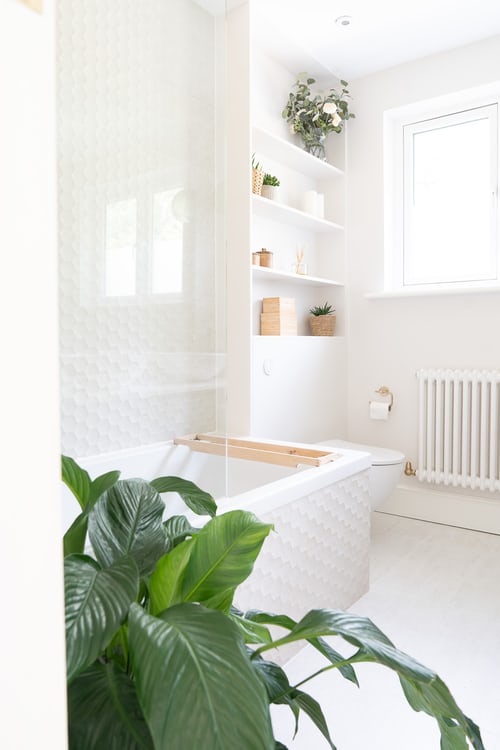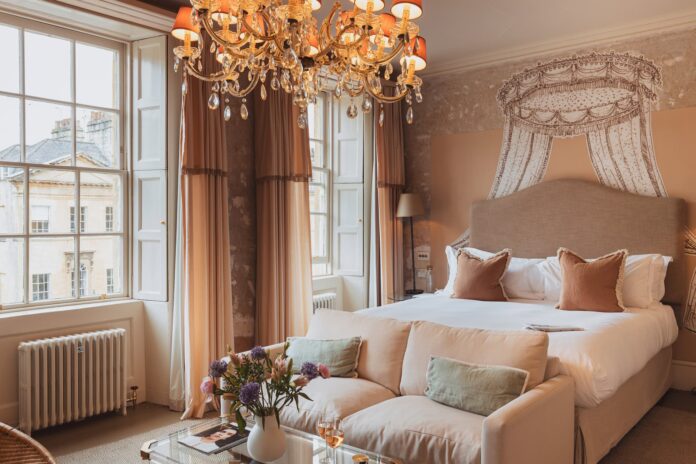While we’d all love a bathtub we could take a swim in, or a toilet seat which does all the dirty work for us, the reality is that for many, the bathroom is a functional room at best.
But did you know the average person spends more than two years in the bathroom? That’s a whole lot of time spent on the toilet, in the bath, under the shower and all the rest, regardless of the size of the space. Which, for the most of us, is generally on the smaller side, let’s be honest…
That doesn’t mean you can’t make the most of this limited space, to make the room into somewhere you want to spend time. It all starts with generating more real estate. Or at least, giving the illusion of space. Here’s how to do both, and make your small bathroom look bigger in 7 IDEAL steps.
Use Frameless Shower Units
That shower curtain over bath scenario just isn’t a good look. Nor is it particularly convenient, let’s be honest. Use less space and make more of it, with a modern, sleek glass shower unit with frameless shower doors.
These serve to make bathrooms look a lot bigger because they’re not cutting off space visually. By removing any visual obstruction, you’re left with an open and airy space to bathe or shower in. Be conscious that if you choose to use textured glass the same effect is unlikely, as it’ll act like a wall. It may also look pretty dated. Just sayin’.


Bigger Mirrors
There’s a reason why so many interior designers place emphasis on using mirrors to create more space across their designs. If you want to make your small bathroom appear larger without having to invest in costly solutions, a few simple mirrors – or one large one, for that matter – can work wonders.
In fact, go for the largest mirror that the bathroom can take. Mirrors are great for reflecting light and open up spaces effectively. A full length, or full wall mirror, can create the impression of having double the space. And that’s what you’re here for right?


Shower Enclosures
Everybody knows just how relaxing it can be to take a soak in the tub after a long day. However, when it comes to utilising the space in a smaller bathroom you’ll probably want to reconsider your bath versus shower cubicle options.
Though you may think that adding a bath with shower enclosures overhead is going to give you the best of both worlds, the truth is that baths aren’t exactly petite.
Instead, we’d highly recommend opting for shower units or cubicles in replacement of a bath, if space saving is your main concern. Shower enclosures are inexpensive and easy to fit, and there are lots of spa-like shower designs out there to take advantage of if you value the relaxing quality of a good soak, including modern hydro shower cabin options from companies like Vidalux.
Tile Right To The Ceiling
As we mentioned earlier, eliminating obstructions in a small bathroom space should be your priority if an improved impression of spaciousness is your end goal. You can do this by ensuring that your tiles go all the way up to the ceiling. If you leave a small space of a painted wall or wall trim above your tiling, you’ll make the space appear cramped – unfinished, even.
For a more seamless look, extend those tiles all the way. Avoid using patterned tiles as this can create a busy space that can end up looking cluttered.



Blend Your Colours
While contrasting, block colours can bring about a unique finish to a bathroom, you should avoid channelling this energy in smaller spaces; the effect can often be on the dingy side. Instead, harness the power of tiles, contrasting with the colour of the rest of the space, to act as a visual divider. Or, if you’re keeping with paint and wallpaper, lighter colours as a general rule of thumb are best for making any room look as big as possible.
Recesses & Clever Storage Solutions
Recessed medicine cabinets, toilet roll holders, and soap dishes pry out more space. Compared to cabinets built out, recessed ones offer more room to bend over and use the sink. You’ll gain more space without foregoing sleekness.
Using recessed light also makes a tiny bathroom appear spacious. Consider recesses since they don’t cost much in the grand scheme of your remodelling.
By building shelving units into the existing wall structure rather than building outwards, space is saved on a foundational as well as visual level. If you’re lucky enough to have any alcoves in your bathroom that you can make use of this way, then do so! Recessed shelving can be fairly easy to install and the extra graft will certainly pay off in the long-run.
Also, we don’t need to tell you that hidden bathroom storage is better than having stuff exposed; but we’ll reiterate that point nonetheless.
Keeping things clean is equally as important as keeping them uncluttered, we think. It might sound obvious, but when you let your bathroom become dirty, you might find that it’s a great deal more difficult to unwind in. Make a regular schedule for cleaning and stick to it. If you have a houseful of people regularly using the bathroom, then set up a rota for cleaning.


Let Natural Light Flow
One of the most effective ways to create an illusion of space is to maximise natural light in your bathroom. If you’re lucky enough to have a window, make sure you’re not blocking it with heavy blinds or frosted treatments that diminish light flow. Instead, opt for lightweight, sheer window coverings or frosted film that maintains privacy while letting sunlight stream through.
For ground floor bathrooms where privacy is paramount, consider installing a top-hung window or a skylight if possible. These additions not only flood the space with natural light but also create a vertical dimension that draws the eye upward, making the ceiling appear higher. If structural changes aren’t an option, using light-reflective materials for your bathroom fixtures and fittings will help bounce whatever natural light you do have around the room, amplifying its space-enhancing effects.
Lights Up
Drab and dreary lighting isn’t going to do much aesthetically for any interior space and this is especially illuminative for bathrooms. While shoddy lighting can result in making a bathroom feel tighter on space than it actually is, properly considered brightness can have the opposite effect. By introducing both general and task lighting you’re going to instantly open up the area.
Make sure the lighting you choose doesn’t cast shadows of any kind; in a compact space shadows only serve to enhance that sense of dinginess.





